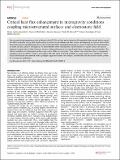Critical heat flux enhancement in microgravity conditions coupling microstructured surfaces and electrostatic field
Author(s)
Garivalis, Alekos Ioannis; Manfredini, Giacomo; Saccone, Giacomo; Di Marco, Paolo; Kossolapov, Artyom; Bucci, Matteo; ... Show more Show less
DownloadPublished version (2.109Mb)
Publisher with Creative Commons License
Publisher with Creative Commons License
Creative Commons Attribution
Terms of use
Metadata
Show full item recordAbstract
<jats:title>Abstract</jats:title><jats:p>We run pool boiling experiments with a dielectric fluid (FC-72) on Earth and on board an ESA parabolic flight aircraft able to cancel the effects of gravity, testing both highly wetting microstructured surfaces and plain surfaces and applying an external electric field that creates gravity-mimicking body forces. Our results reveal that microstructured surfaces, known to enhance the critical heat flux on Earth, are also useful in microgravity. An enhancement of the microgravity critical heat flux on a plain surface can also be obtained using the electric field. However, the best boiling performance is achieved when these techniques are used together. The effects created by microstructured surfaces and electric fields are synergistic. They enhance the critical heat flux in microgravity conditions up to 257 kW/m<jats:sup>2</jats:sup>, which is even higher than the value measured on Earth on a plain surface (i.e., 168 kW/m<jats:sup>2</jats:sup>). These results demonstrate the potential of this synergistic approach toward very compact and efficient two-phase heat transfer systems for microgravity applications.</jats:p>
Date issued
2021Department
Massachusetts Institute of Technology. Department of Nuclear Science and EngineeringJournal
npj Microgravity
Publisher
Springer Science and Business Media LLC
Citation
Garivalis, Alekos Ioannis, Manfredini, Giacomo, Saccone, Giacomo, Di Marco, Paolo, Kossolapov, Artyom et al. 2021. "Critical heat flux enhancement in microgravity conditions coupling microstructured surfaces and electrostatic field." npj Microgravity, 7 (1).
Version: Final published version